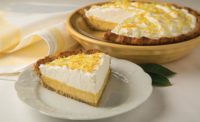State of the Industry 2017: Desserts still hit the sweet spot for consumers
Foodservice and better-for-you trends are top influencers.





courtesy of Eli’s Cheesecake

courtesy of Hinds Bock


courtesy of Eli’s Cheesecake

Pie & Cake sales

Pie sales

Frozen Cheesecake sales











If there’s one place consumers are willing to indulge in something decadent, it might be at their favorite restaurant. And when it comes to the end of the meal and the prized desserts that await, research from Datassential, Chicago, shows that consumers are still choosing sweets.
Overview | Bread | Tortillas | Sweet Goods | Snack Cakes | Pizza | Desserts | Cookies | Buns & Rolls | Bars | Breakfast Products
Datassential reports that nine out of 10 restaurants in America serve dessert, with the top five menu items being cake, ice cream, cheesecake, cookies and pies (in that order). And while most demographics are either eating the same amount or decreasing their consumption of desserts, millennials are more likely to say they’re increasing their consumption.
When it comes to packaged options, restaurant trends are trickling down and impacting sales. “Research shows that consumers are most likely to try a new food trend in a restaurant and then look for a way to bring their experience home by shopping that trend at the grocery store,” explains Doon Wintz, president, Wholly Wholesome, Chester, NJ.
Market data
According to IRI, Chicago, sales of desserts at retail are healthy. The pies and cakes segment was up 5.3 percent for the 52 weeks ending March 19, 2017, hitting $1.9 billion. When broken into segments, cakes were up 4.4 percent to $1.5 billion, while dollar sales of pies climbed 8.2 percent to $442.5 million. Private label leads both segments by a wide margin.
In fact, the only segment where private label doesn’t have a strong top position is in frozen pies, where it holds the No. 4 spot.
According to the IRI data, more shoppers might be opting for fresh vs. frozen options. Frozen pie dollar sales dropped 3.20 percent to $516.0 million. The same pattern surfaced in cheesecakes, with frozen cheesecake sales dropping 12.83 percent to $123.0 million, while dollar sales of refrigerated cheesecakes increased 16.40 percent to $277.2 million.
Refrigerated cakes and pies is a minor segment, but both showed growth over the past year. Sales of refrigerated cakes grew 5.46 percent to reach $130.4 million. Dollar sales of refrigerated pies rose 4.90 percent to $31.5 million.
Wintz notes that some growth within the desserts category is in the better-for-you niche. “This includes organic, allergy-friendly, vegan, and/or low-sugar—particularly products that are naturally low in sugar, rather than those sweetened artificially,” he says.
Looking back
Though a traditionally decadent and indulgent category, desserts are not exempt from the clean label trend affecting nearly every facet of the food industry. Whether it’s nutrition or transparency, simple ingredients or gluten-free, clean label is one consumer demand that’s not going anywhere.
And that could be a challenge for some brands, says Kurt Villwock, director of research and development, Fiberstar, Inc., River Falls, WI. “Depending on the customer’s clean label definition, it could mean using kitchen cupboard ingredients, reducing the number of ingredients in a statement, and/or removing allergenic components.” It could also mean reducing negatively perceived product aspects such as calories, saturated fat or added sugars to improve the dessert’s impact on health.
Villwock says that ingredient options for water-binding, thickening or emulsifying functionalities in desserts are diminishing as the definition of clean label gets more expansive and inclusive. In response, Fiberstar offers Citri-Fi, a line of natural citrus fibers that is a clean label alternative to pure pectin for jam and jelly fillings, and also provides high water-holding capacity and emulsification properties.
Eli’s Cheesecake Co. has a clean label for its No. 1 seller, Eli’s Original Plain Cheesecake, made with cultured cream cheese, cultured sour cream, Madagascar bourbon vanilla, butter, eggs and sugar. It has also introduced GMO-free ingredients into its portfolio, including those that appear in its Cookie Butter Cheesecake and miniature pies. Non-dairy cheesecakes appeal to the vegan or allergy-sensitive audience, and are made with tofu.
“There has been a continued movement to marry the concept of nutrition and foods that normally would not be associated with nutrition,” comments Wintz, “whether that means fortifying a dessert with antioxidants or incorporating an ingredient as apparently nutritious as an açaí or goji berry. Protein and probiotics, as well, have entered the dessert category, making it much less of a ‘health sacrifice’ in the eyes of health-minded consumers.”
One other way consumers are taking a healthier approach to dessert is through smaller serving sizes, and miniature or single-serve options remained popular over the past year. Sara Lee, a Hillshire Brands business, introduced single-serve cheesecake slices to its portfolio in January 2016, and Portland Style Cheesecake and Dessert Co. launched miniature 3-inch cheesecakes and cakes in the same month. Sara Lee grew its refrigerated cheesecake business by 254.19 percent to $3.1 million.
The Father’s Table also offers single-serving and reduced-size cheesecake products. In refrigerated cheesecakes, The Father’s Table is the No. 2 company in the segment, and was up 3.62 percent for the year to $53.5 million.
Lance Aasness, executive vice president of Hinds-Bock Corporation, Bothell, WA, has noticed manufacturers getting creative in this area, offering dessert shots or desserts on a stick (think small cheesecake slices dipped in chocolate ganache and served semi-frozen) to meet demand. To meet the mini trend, the company offers a dual servo orbiting multi-piston high speed depositing system, which can run 2,700 miniature products per minute.
Colborne Foodbotics, Lake Forest, IL, has also introduced new equipment to help manufacturers produce single-serve desserts, “through special conveyor technology combined with our proprietary depositor designs,” says Rick Hoskins, president.
At Eli’s, new introductions to meet this demand include Mini Pies and Cheesecake Cuties, measuring 1.7 oz. and 1-inch-square, respectively, which Debbie Marchok, vice president of marketing, says “allows the consumer to ‘treat themselves’ to an indulgent dessert with portion control.”
Looking forward
Going forward, there are two distinct areas of opportunity.
The first takes the clean label trend and expands upon it, including transparency at all levels. Aasness believes that manufacturers are wise to get back to basics with their ingredients, so there’s truly nothing to hide on the label. “By that I mean less-processed, full-flavor ingredients, real butter, real cream, unrefined sugar, unrefined flowers and fewer GMO ingredients,” he said, “just like you see in many parts of Europe.”
But it doesn’t end on the label. Wintz believes companies that show clean production practices, as well, will find success. A farm-to-fork approach will be favored, he adds. “For companies dedicated to true transparency and an open dialogue with consumers, offering an immersive look at their company, their brand and its products is certainly a progressive next step.”
The second area of opportunity concerns flavors. While Datassential reports that the top growing flavors in desserts are still sweet favorites like Nutella, marshmallow, red velvet and butterscotch, the consumers of tomorrow will be captured not by the familiar, but by the exotic.
“Ethnic flavors are more common now on menus, and these influence the retail products as consumers would like to experience the same flavors and textures at home,” says Carlos Fajardo, technical business development manager, Palsgaard, Morris Plains, NJ.
Eli’s is incorporating such trends with savory, southern and ethnic flavors in desserts, such as Salted Caramel Cheesecake, Blackberry Sour Cream Cheesecake and Honey Almond Cheesecake, drawing inspiration from eastern Mediterranean flavors. And, of course, a vibrant and fun category like desserts can capitalize on one hot trend, says Marchok: “Unicorn everything. Colorful desserts will reign in 2017.”
Overview | Bread | Tortillas | Sweet Goods | Snack Cakes | Pizza | Desserts | Cookies | Buns & Rolls | Bars | Breakfast Products
Looking for a reprint of this article?
From high-res PDFs to custom plaques, order your copy today!

















